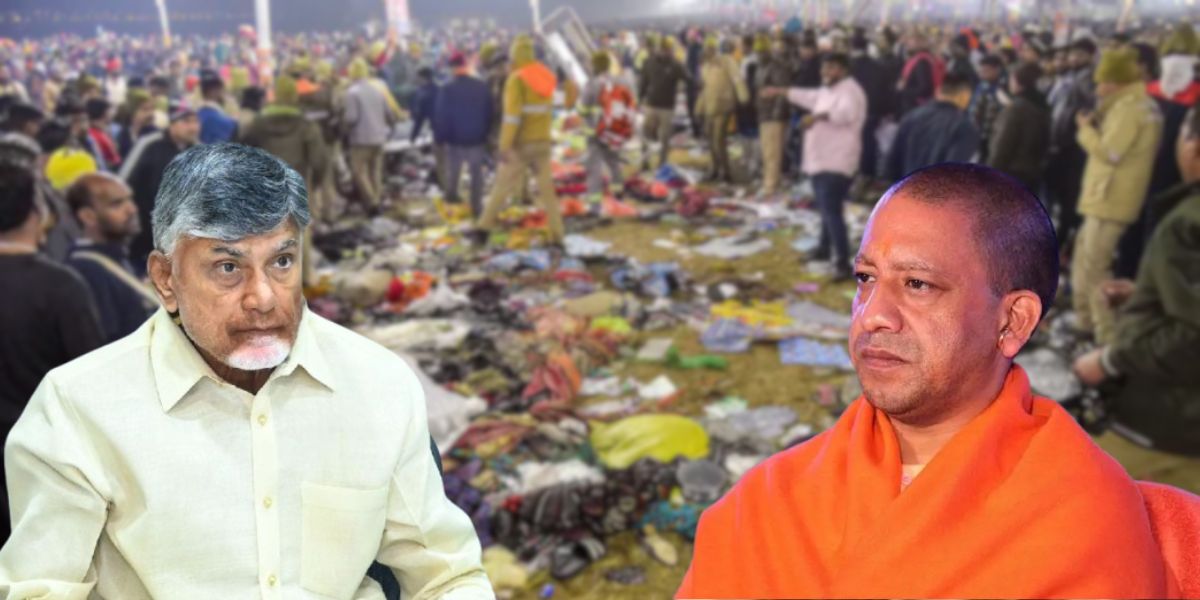The Uttar Pradesh government’s reaction to the Kumbh Mela stampede, that killed 30 people, is a textbook case of how a government should not handle a tragedy. The heartbreak and anger over the loss of lives was only compounded by the Yogi Adityanath government’s attempt to downplay it for hours.
Published Jan 30, 2025 | 2:10 PM ⚊ Updated Jan 30, 2025 | 2:28 PM

Andhra Pradesh handled the tragedy better and in a professional manner than Uttar Pradesh.
Information blackout for over 15 hours, underplaying deaths of Hindu devotees, refusing to acknowledge the severity of a huge tragedy, lack of coordination with other state governments, leaving desperate families in the lurch, crying hoarse about “rumours” despite condolence messages pouring in over people crushed to death and all this while managing headlines on flower showers – this is how the Yogi Adityanath-led Uttar Pradesh government chose to respond to the stampede in Maha Kumbh Mela.
Acknowledging the severity of the tragedy sensitively, communicating with distraught kin, sharing details of those affected with respective state governments to initiate coordination relief measures, setting up helplines and help desks, timely updates on deceased and injured, prioritising human lives over image management, fixing accountability and taking corrective measures is ideally how a responsible government should have responded.
The heartbreak and anger over the loss of lives was only compounded by the Yogi Adityanath government’s attempt to downplay it for hours, refusing to even acknowledge deaths.
As many as 30 devotees were crushed to death in the tragic stampede at Uttar Pradesh’s Prayagraj where Maha Kumbh mela is underway. For over 15 hours, the BJP government led by Adityanath refused to even acknowledge the magnitude of the tragedy — leaving grieving and worried families, state governments awaiting communication and media asking questions on death toll to assume the worst.
After over 15 hours of claiming, “it wasn’t a stampede”, “it was just a crowd surge”, “don’t listen to rumours”, “it was a small incident”, “can’t really tell you about casualties yet”, when the Uttar Pradesh government finally decided to come clean: the death toll was worse than initially feared.
Thirty people, who were to participate in Maha Kumbh, the largest Hindu congregation, were killed in a stampede. On Wednesday evening, Uttar Pradesh police said 60 others were injured in the incident. Four among those dead in the stampede were natives of Karnataka.
Yet, such was the information blackhole created by Uttar Pradesh authorities that even Karnataka government had no official communication on the list of deceased or injured. Karnataka had to rely on local information gathering to identify families who were worried about their loved ones. Karnataka set up a helpline number and appointed nodal officers to travel to Uttar Pradesh and assist citizens from the state.
From President Droupadi Murmu to Prime Minister Narendra Modi, leaders condoled the death of devotees in the Maha Kumbh stampede, but Yogi Adityanath and his administration appealed to “not listen to rumours” while refusing to acknowledge deaths.
Barely weeks ago, on the night of 8 January 2025, a stampede in Tirupati killed six devotees. The rush to get tokens for Vaikunta Dwara Darshana of Lord Balaji led to chaos, which also injured at least 30 others.
There’s a stark difference between how Andhra Pradesh Chief Minister N Chandrababu Naidu responded to the Tirupati stampede and Uttar Pradesh Chief Minister Adityanath responded to the Maha Kumbh stampede.
The stampede in Tirupati took place at around 9.45 pm. By 10.49 pm, CM Naidu had taken stock of the situation and acknowledged the loss of lives. The next morning, he was in Tirupati, visiting those injured in the hospitals, consoling families who had lost their kin, and held a review meeting in Tirupati.
Within 14 hours of the deadly stampede, Andhra Pradesh government had ordered a judicial inquiry, two officials — one each from police and TTD — were suspended and three were transferred. An ex gratia of ₹25 lakh was announced for families who lost their loved ones.
Retired High Court Justice Satyanarayana Murthy is now heading the commission of inquiry, which has been directed to submit its findings within six months.
The media in Andhra Pradesh relentlessly reported on the tragedy, the loss of lives and help that affected families needed. It was followed up with details of what TTD and the government was doing to prevent such tragedies. The TTD — the board that governs the richest Hindu temple — apologised to devotees for the tragedy.
This is not a comparison of the two tragedies. Every life lost is a travesty and inconsolable tragedy.
There’s no doubt that it is never the intention of any government for a tragedy to take place. Authorities perhaps even take all measures they can to ensure the best arrangements for security, especially when huge crowds are expected. Despite arrangements, tragedy may strike, but a government’s ability to effectively and sensitively respond to a crisis is what makes it responsible and mature.
The frivolousness with which both — the Uttar Pradesh authorities and mainstream media — focused on the flower showers over loss of human lives, obfuscation over accountability, narrative management over gut-wrenching tragedy that demanded quick, straight answers, shows where their priorities lie.
Unlike the TTD, the Uttar Pradesh government may not want to apologise to devotees for the tragedy, but the very least they could do was give the deceased and injured the dignity of acknowledgement and assurance of assistance. It is not too much to ask.
(Edited by Majnu Babu).
